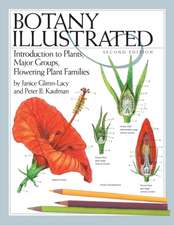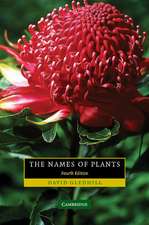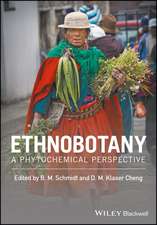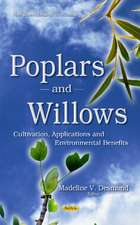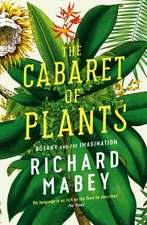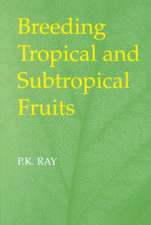Working with Ferns: Issues and Applications
Editat de Helena Fernández, Ashwani Kumar, Maria Angeles Revillaen Limba Engleză Paperback – 12 oct 2014
| Toate formatele și edițiile | Preț | Express |
|---|---|---|
| Paperback (1) | 1385.54 lei 43-57 zile | |
| Springer – 12 oct 2014 | 1385.54 lei 43-57 zile | |
| Hardback (1) | 1389.97 lei 43-57 zile | |
| Springer – 10 noi 2010 | 1389.97 lei 43-57 zile |
Preț: 1385.54 lei
Preț vechi: 1689.68 lei
-18% Nou
Puncte Express: 2078
Preț estimativ în valută:
265.13€ • 277.51$ • 220.67£
265.13€ • 277.51$ • 220.67£
Carte tipărită la comandă
Livrare economică 31 martie-14 aprilie
Preluare comenzi: 021 569.72.76
Specificații
ISBN-13: 9781489981318
ISBN-10: 1489981314
Pagini: 408
Ilustrații: XXII, 386 p.
Dimensiuni: 155 x 235 x 21 mm
Greutate: 0.57 kg
Ediția:2010
Editura: Springer
Colecția Springer
Locul publicării:New York, NY, United States
ISBN-10: 1489981314
Pagini: 408
Ilustrații: XXII, 386 p.
Dimensiuni: 155 x 235 x 21 mm
Greutate: 0.57 kg
Ediția:2010
Editura: Springer
Colecția Springer
Locul publicării:New York, NY, United States
Public țintă
ResearchCuprins
Chapter 1: INTRODUCTIONCONTRIBUTION OF FERNS TO UNDERSTANDING OF PLANT DEVELOPMENTChapter 2 Cellular, molecular and genetic changes during the development of Ceratopteris richardii gametophytesAuthors: Salmi M, Bushart T and Roux S J Chapter 3 Laboratory-induced Apogamy and Apospory in Ceratopteris richardiiAuthors: Cordle AR., Bui LT, Irish EE, and Cheng C-LChapter 4 Sexual reproduction in fernsAuthors: Menéndez V, Revilla A, Peredo E, Revilla MA, and Fernández H.Chapter 5 Gibberellic acid and ethylene control male sex determination and development of Anemia phyllitidis gametophytesAuthor: Kazmierczak A.Chapter 6 The sporophytes of seed-free vascular plants -major vegetative developmental features and molecular genetic pathwaysAuthors: Tomescu A.PROPAGATION, CONSERVATION AND CONTROL OF GENETIC VARIABILITY IN FERNS.Chapter 7 Form spore to sporophyte: How to proceed in vitro Authors: Menéndez V, Arbesú R, Somer M, Revilla A, and Fernández H.Chapter 8 In vitro regeneration systems of PlatyceriumAuthors: Camloh M and Ambrozic-Dolinsek J.Chapter 9 Stipule propagation in five Marattioid species native to Taiwan (Marattiaceae; Pteridophyta)Authors: Huang Y-M, Huang M-H, Chen C-M, Chiou W-LChapter 10 Tree ferns biotechnology: from spores to sporophytesAuthors: Rybczy?ski JJ and Miku?a A.Chapter 11 In Vitro Propagation of Rare and Endangered Serpentine Fern Species Authors: Marsza?-Jagacka J and Kromer KChapter 12 Conservation of fern spores.Authors: Ballesteros D. Chapter 13 Exploration of cryo-methods to preserve tree and herbaceous fern gametophytesAuthors: Miku?a A, Makowski D, Walters C, and Rybczy?ski JJ. Chapter 14 Pteridophyte spores viabilityAutores: Gabriel y Galán JM, and Prada C.Chapter 15 Microsatellites: a powerful genetic marker for fern researchAuthor: Jiménez-Soria A.Chapter 16 Diversity in natural fern populations: dominant markers as genetic tools.Authors: Peredo EL, Revilla MA, Méndez M,Menéndez V and Fernández H.ENVIRONMENTAL BIOTECHNOLOGY: ECOTOXICOLOGY AND BIOREMEDIATION IN FERNS Chapter 17 Mitochondrial activity of fern spores for the evaluation of acute totoxicity in higher plant developmentAuthors: Catalá M, Esteban M and García L. Chapter 18 Chronic phytotoxicity in gametophytes: DNA as biomarker of growth and chlorophyll autofluorescence as biomarker of cell functionAuthors: Catalá M and Rodriguez-Gil JL. Chapter 19 Arsenic hyperaccumulator fern Pteris vittata: Utilities for arsenic phytoremediation and plant biotechnologyAuthor: Rathinasabapathi B.Chapter 20 Aerobiology of Pteridophyta spores: preliminary results and applicationsAuthor: Rodriguez de la Cruz D. THERAPEUTICAL/MEDICINAL APPLICATIONSChapter 21 Studies on Folk Medicinal Fern: An example of “Gusuibu”Author: Chang H-C, Gupta SK and Tsay H-S.Chapter 22 Ecdysteroids in Ferns: diversity, distribution, biosynthesis and functionsAuthors: Lafont R, Ho R, Raharivelomanana P and Dinan L.Chapter 23 Ferns - from traditional uses to pharmaceutical development; chemical identification of active principlesAuthors: Ho R, Teai T, Bianchini JP, Lafont R and Raharivelomanana P. Chapter 24 Functional activities of ferns for human healthAuthors: Lee CH and Shin SL. Chapter 25 Toxicological and medicinal aspects of the most frequent fern species Pteridium aquilinumAuthor: Vetter J.
Notă biografică
Ashwani Kumar Professor, Department of Botany, University of Rajasthan, Jaipur. The author’s repertoire of published works spreads across 150 research articles in various national and international journals. He has an experience of over three decades in his field of research, namely, tissue culture and biochemistry, being awarded with prestigeous V. Puri Medal in 2008 for his services to advancement of Botany.Helena Fernández Associate Professor, Department of Biology of Organisms and Systems, Oviedo University, Spain. Her research focuses on micropropagation and reproduction in ferns during the two last decades. In 2002 she obtained the award “Ramón y Cajal” by The Ministry of Science and Technology, being engaged to the Oviedo University as tenurer, full time, in the Area of Plant Physiology since then. M. Angeles RevillaPlant Physioloy Assistant Professor in the Biology Faculty at the Oviedo University (Spain) since 1987. Twenty years experience in plant tissue culture. She has also worked in cryopreservation and genetic stability for the last ten years, mainly in the development of protocols for in vitro shoot apices in agronomic species.
Textul de pe ultima copertă
Ferns existing today represent a genetic inheritance of great value as they include species of ancient vascular plants, which have direct connection with the crucial steps done in the past for settling life on Earth. Their life cycle is an example of alternation of generations, in which both a multicellular diploid organism and a multicellular haploid organism occur and give rise to the other. Spore, gametophyte and sporophyte have been studied either for basic and practical purposes. In the first case, they offer us simple and easy to grow experimental systems to investigate on plant development, and secondly, they are culture by their ornamental appeal, their environmental benefit or as source of metabolites. This timely volume brings a selection of chapters, each one composed by experts in their respective fields. The chapters included cover a broad range from the knowledge of its biology and contribution to understanding of plant development, useful protocols for propagation and conservation purposes, genetic variability as well as environmental and theurapeutical applications. This wide spectrum of the contributions gives to reader a rapid idea of the enormous potential of this plant group.The originality of this book is to expose the most recent tendencies in their investigation, which is far from the traditional perspective usually followed. The collected articles in this volume incorporate most of novel techniques used nowadays routinely to resolve traditional questions. Ashwani Kumar Professor, Department of Botany, University of Rajasthan, Jaipur. The author’s repertoire of published works spreads across 150 research articles in various national and international journals. He has an experience of over three decades in his field of research, namely, tissue culture and biochemistry, being awarded with prestigeous V. Puri Medal in 2008 for his services to advancement of Botany.Helena Fernández Associate Professor, Department of Biology of Organisms and Systems, Oviedo University, Spain. Her research focuses on micropropagation and reproduction in ferns during the two last decades. In 2002 she obtained the award “Ramón y Cajal” by The Ministry of Science and Technology, being engaged to the Oviedo University as tenurer, full time, in the Area of Plant Physiology since then. M. Angeles RevillaPlant Physioloy Assistant Professor in the Biology Faculty at the Oviedo University (Spain) since 1987. Twenty years experience in plant tissue culture. She has also worked in cryopreservation and genetic stability for the last ten years, mainly in the development of protocols for in vitro shoot apices in agronomic species.
Caracteristici
expose the most recent tendencies in their investigation, which is far from the traditional perspective followed.
collected articles in this volume incorporate most of novel techniques used nowadays routinely to resolve traditional questions.
volume brings a selection of chapters, each one composed by experts in their field.
collected articles in this volume incorporate most of novel techniques used nowadays routinely to resolve traditional questions.
volume brings a selection of chapters, each one composed by experts in their field.


